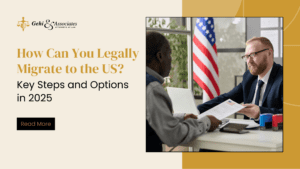
The United States remains a top destination for those seeking better opportunities, family reunification, or a fresh start. However, how can you legally migrate to the US in 2025 without delays, denials, or legal complications?
The answer is understanding the right visa options, processing windows, and lesser-known opportunities that many overlook. Some pathways offer faster approvals, while others provide more flexibility for investors, skilled professionals, and entrepreneurs. To avoid mistakes that could set you back years, legal guidance from an experienced Queens immigration attorney is what you need.
How Can You Legally Migrate to the US in 2025 Using The Fastest Immigration Pathways?
Are you wondering “How can you legally migrate to the US” while avoiding long backlogs? Then you need to understand how processing times work. In 2025, USCIS processing speeds are influenced by demand, staffing levels, policy adjustments, and workload distribution. According to the FY 2024 DHS Annual Performance Report, USCIS prioritizes reducing adjudication delays. At the same time, handling employment-based visas, family-sponsored green cards, and investor petitions.
Despite ongoing efforts, some pathways remain significantly faster than others, particularly for employment-based visas, fiancé(e) visas, and specialized investor programs. Let’s explore the fastest immigration options in 2025, their approval rates, and processing trends.
EB-1 Green Cards
How can you legally migrate to the US using the EB-1 visa? For highly skilled individuals, the EB-1 visa remains one of the quickest routes to a green card. In 2024, USCIS processed I-140 immigrant worker petitions in an average of 7.7 months, up from 4.7 months in the prior year.
Who Qualifies for EB-1?
- Individuals with extraordinary abilities (EB-1A)
- Outstanding researchers or professors (EB-1B)
- Multinational executives and managers (EB-1C)
EB-1 applicants do not require labor certification, making this an attractive fast-track option. However, due to increasing demand, processing times could fluctuate in FY 2025.
K-1 Fiancé(e) Visa
This applies to those engaged to a U.S. citizen. The K-1 fiancé(e) visa offers a rapid legal entry to the U.S. before adjusting to a green card. In FY 2024, USCIS continued to meet its target of processing family-based I-485 applications within 8 months.
Processing Timeline for K-1 Visa
- 6–10 months for visa approval
- 90-day period to marry after entry
- Adjustment of status (green card) takes 8–12 months
The nonimmigrant NAFTA Professional (TN) Visa
Under NAFTA/USMCA, Canadian and Mexican professionals can obtain TN visas within weeks. The latest USCIS data shows nonimmigrant worker petitions (I-129), including TN visas, were processed in an average of 3.1 months.
Who Qualifies for TN Visas?
- Canadian or Mexican nationals
- Professionals in engineering, science, education, IT, and healthcare
- Must have a valid job offer from a U.S. employer
Unlike the H-1B visa, TN visas do not have an annual cap, making them a less competitive option for skilled workers.
H-1B Premium Processing
The H-1B visa, typically taking several months, can be fast-tracked to just 15 days with premium processing. This expedited service, however, does not increase visa approval chances, it only speeds up adjudication.
Who Should Consider Premium Processing?
- STEM professionals, IT experts, doctors, and finance specialists
- Those in high-demand fields with employer sponsorship
- Applicants facing time-sensitive job offers
Investor and Entrepreneur Visas
Investment-based immigration options range widely in processing times. The EB-5 Immigrant Investor Program remains a longer route, often taking several years. However, alternatives like the E-2 Treaty Investor Visa provide faster adjudications.
EB-5 Visa Processing Times and Approval Rates
- Processing times: I-526E petition approvals remain delayed, with 90% of high unemployment area cases and 80% of rural cases still pending.
- High approval rates: 93% for high unemployment projects and 96% for rural projects, making EB-5 an attractive but time-consuming option.
Faster Alternative: E-2 Treaty Investor Visa
For those from treaty countries, the E-2 visa processes in as little as 2–4 months. Unlike EB-5, E-2 does not lead directly to a green card, but investors can later transition to EB-2 NIW.
To ensure the fastest and smoothest approval process, working with an experienced Queens immigration attorney is highly recommended. Mistakes, missing documents, or misfiling can cause costly delays, turning a 6-month wait into years.
Work Visa Categories That Can Lead to a Green Card
The H-1B visa may be the most well-known work visa. However, how can you legally migrate to the US if you’re looking for faster processing times and fewer restrictions? Or a better pathway to a green card? Many of these visas have higher approval rates and are underutilized compared to the H-1B program.
O-1 Visa
The O-1 visa is a great option for highly talented professionals, researchers, artists, and business leaders. Unlike the H-1B, which is subject to a lottery system, the O-1 visa has no annual cap. This makes it a more accessible choice for individuals who can demonstrate exceptional achievements in their field.
Processing Time and Approval Trends:
- The O-1 visa approval rate remains high, largely because applicants must prove significant recognition in their industry.
- As of FY 2024, the average processing time for an O-1 visa is around 2.7 to 3.1 months, significantly faster than the H-1B process.
- The O-1 visa is dual intent. This means applicants can transition to a green card via the EB-1 category, which has priority processing and fewer backlogs.
E-2 Visa
For entrepreneurs from treaty countries, the E-2 visa provides an opportunity to live and work in the U.S. while running a business. It is not a direct path to a green card. However, E-2 investors can transition to permanent residency through the EB-2 National Interest Waiver (NIW).
Key Advantages of the E-2 Visa:
- There is no minimum investment amount, but most successful applicants invest at least $100,000–$150,000.
- The E-2 visa has no annual cap, unlike the EB-5 investor visa, which has a 10,000 visa limit per year.
L-1 Visa
The L-1 visa is perfect for multinational companies transferring employees to the U.S. It provides a direct path to a green card through the EB-1C category, which is faster and has higher approval rates.
Processing and Green Card Transition:
- The L-1 visa processing time is 4–8 months, depending on premium processing availability.
- Unlike the H-1B, there is no lottery, making it a more predictable option for executives and specialized employees.
- L-1 visa holders qualify for EB-1C green cards, which have shorter processing times compared to EB-2 or EB-3 categories.
P-1 Visa
The P-1 visa is designed for athletes, musicians, and entertainment professionals coming to the U.S. for work in their field. While not widely discussed, the P-1 visa can lead to a green card under certain conditions.
Key Considerations for P-1 Visa Holders:
- P-1 holders may transition to permanent residency through the EB-1 or EB-2 NIW categories. That is if they can demonstrate sustained international recognition.
- P-1 visas are approved faster than H-1B visas, with an average processing time of 2.7 to 3.1 months.
- Unlike H-1B, which is limited to STEM and professional roles, the P-1 visa caters to a broader range of industries.
If you are an entrepreneur, executive, artist, or skilled professional, these options may provide a stronger chance of securing permanent residency.
How Can You Legally Migrate to the US Using Family Sponsorship To Speed Up the Process?
For many immigrants, family sponsorship is the most reliable way to obtain lawful permanent residency. However, long wait times and backlogs can delay reunification for years. What many applicants don’t realize is that several legal strategies can expedite the process. If you’re wondering, “How can you legally migrate to the US?” These pathways, though often overlooked, significantly reduce waiting periods under specific circumstances.
Military Parole-in-Place (PIP)
One of the most powerful, yet underused, immigration benefits available to families of U.S. military members is Parole-in-Place (PIP). Under this policy, spouses, children, and parents of active-duty military members, veterans, and reservists may receive parole. This allows them to adjust their status without having to leave the U.S.
Key Benefits of Military PIP:
- Avoids the Need for Consular Processing: Normally, individuals who enter the U.S. without inspection must leave and apply for a visa at a U.S. consulate. This often triggers long reentry bars. PIP allows eligible family members to adjust their status inside the U.S. instead.
- Work Authorization Available: Applicants granted PIP can apply for work authorization, giving them legal employment rights during the adjustment process.
- Higher Approval Rates: The discretionary nature of PIP means cases with strong supporting evidence have a high success rate.
Age-Out Protections for Children
One of the most frustrating experiences for immigrant families is when a child “ages out”. That is when the child turns 21 before their green card application is approved. This forces them into a much longer waiting category.
Thanks to the Child Status Protection Act (CSPA), certain children can retain eligibility even after turning 21 under specific conditions.
How CSPA Helps Families Avoid Delays:
- If a parent has an approved I-130 or I-140 petition and the child was under 21 at the time of filing. CSPA freezes the child’s age during processing, preventing them from moving into a longer visa queue.
- If the processing time of the green card application was significantly delayed due to USCIS backlogs. Then CSPA may allow the child to subtract those delays from their age calculation, keeping them eligible.
- Sometimes, aged-out children may opt for the F-2B visa category. This category has a shorter backlog compared to other family preference categories.
Expedited Spousal Visa Processing
Some factors allow for faster processing for U.S. citizens and lawful permanent residents petitioning for their spouses.
Factors That May Qualify a Case for Expedited Processing:
- USCIS Errors or Processing Delays: If USCIS fails to forward an approved I-130 to the National Visa Center (NVC) within 2 months. Then the applicant can request expedited handling.
- Employment-Related Relocation: If a U.S. citizen spouse must relocate abroad for work. Then they may request USCIS to expedite the I-130 petition based on hardship and national interest grounds.
- Medical Emergencies or Humanitarian Reasons: If the sponsored spouse requires urgent medical care in the US. For treatment that is unavailable in their home country, USCIS may expedite processing on humanitarian grounds.
Consular Processing
How can you legally migrate to the US with consular processing? For applicants outside the U.S., consular processing can take years. However, in some cases, the provisional waiver (I-601A) can drastically reduce time abroad. Normally, if a family member is ineligible to adjust status in the U.S., they must leave the country and apply from abroad. Triggering a 3- or 10-year bar. The I-601A waiver allows eligible applicants to file the waiver while still inside the US. Reducing the amount of time spent outside the country to as little as 1-2 months rather than years.
Your Pathway to Success Starts with the Right Queens Immigration Attorney
How can you legally migrate to the US? There are many ways to do this. You can apply for a green card, work visa, or family sponsorship. However, make sure to enlist the help of an experienced Queens immigration attorney to increase your chances of success. Even the most straightforward applications can face unexpected roadblocks that’s why having the right legal is essential.
Take control of your immigration journey today by booking a free consultation now. Remember, the right opportunity awaits you, and the right attorney can help you reach it.




